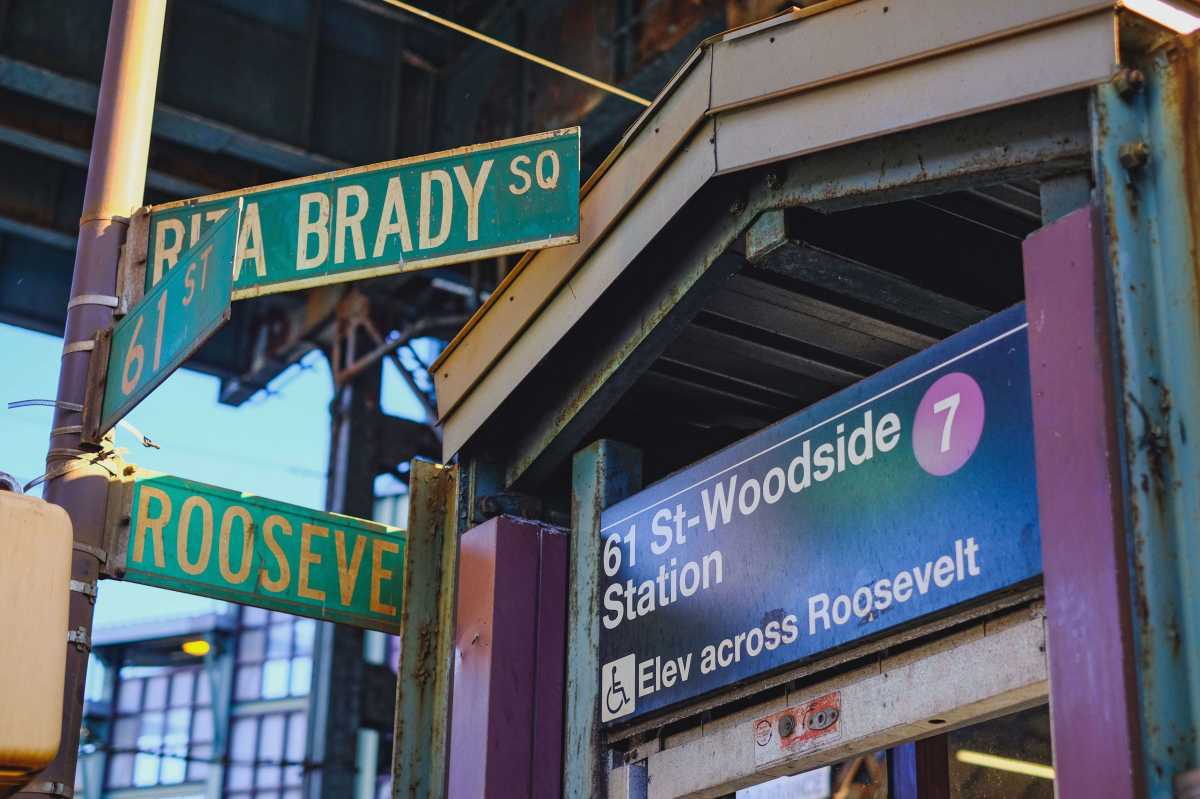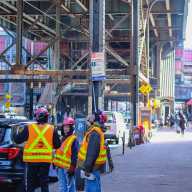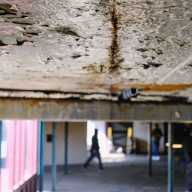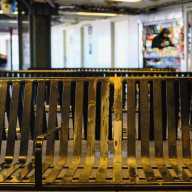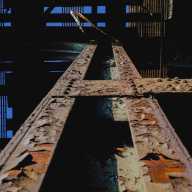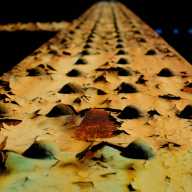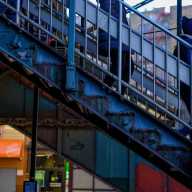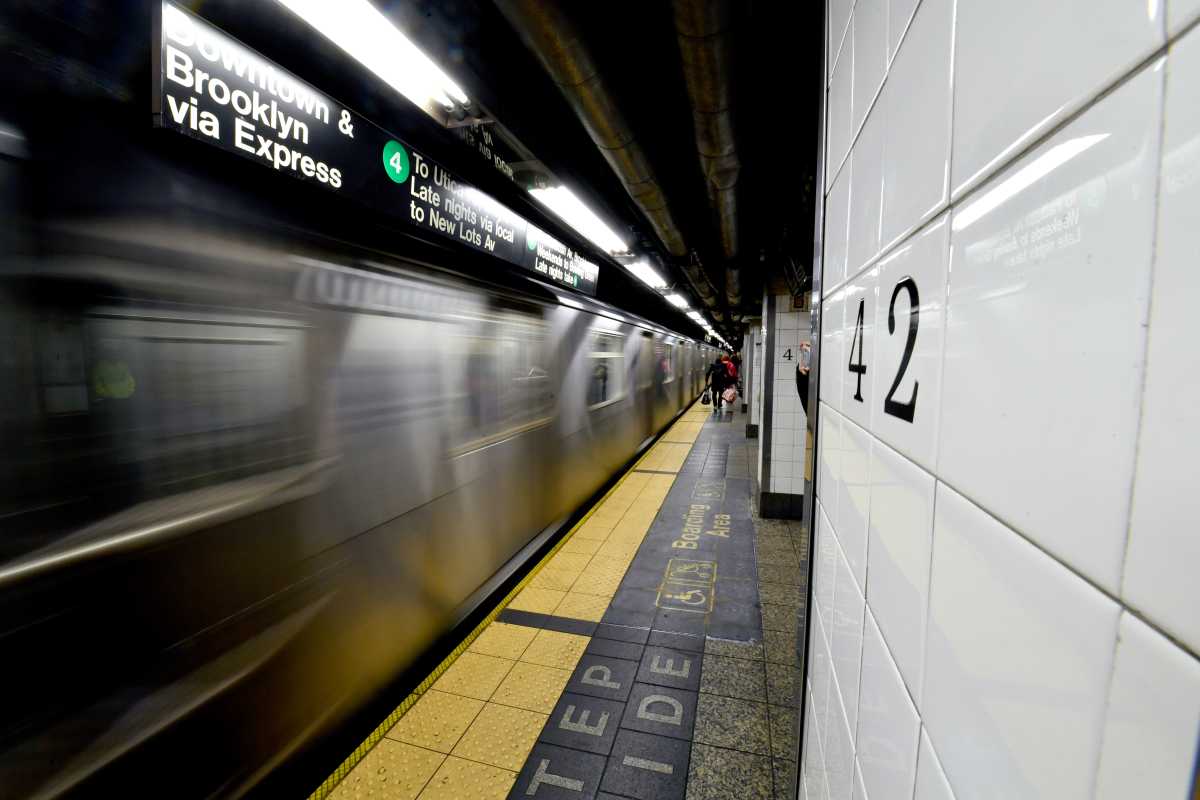Nothing draws to mind the MTA’s myriad systemic problems — or the darker days of New York City’s bankrupt past — like the Woodside-61st Street Station, where the 7 train and the Long Island Rail Road intersect in a towering multilevel hub of decaying steel.
And the declining state of the station and the trestle on each side are not lost on the people who depend on the foot traffic through the area most: the street vendors.
One man on the northeast corner of Roosevelt Avenue and 61st Street shook his head on a recent morning as he indicated toward the most dilapidated parts of the station. He claimed it is not uncommon to see objects falling down to street level.
A woman working a Mexican food cart underneath the railroad tracks told QNS she is cautious of the lead paint she knows could be showering down on her workspace throughout the day.
There are likely dozens of halal and taco carts along the entire length of the train as well as open-air markets, restaurants and residences.
Early on Monday morning, March 11, New York City Transit and LIRR crews were seen working to ensure the tracks are safe after two recent incidents where debris broke off causing significant damage to cars passing by underneath.
One vehicle in late February was pierced through the windshield by a wooden beam on the east side of the station – up above are more slats – and an incident on March 6 in which a piece of rusted metal dropped onto the roof of another car.
“Rubble from up there fell and hit a little red car crashing all the glass from the windshield. Two people who were inside, a lady and a gentleman came out and called the police from the sidewalk and made the report. They began to arrive, those people from the MTA. They went up to see what fell and then came back down and entered the store with the gentleman and the police that arrived,” said Anibal Bravo, a worker at a hardware store located on Roosevelt Avenue and 61st Street.
True to its word, the MTA was conducting inspections and a crew preoccupied with the tracks above told QNS they were surveying the entire length of the tracks. A Long Island Rail Road crew said they addressing issues with age as they sawed at a section of the overpass on 61st Street dating back to 1913.
“It’s mostly just old,” one of the crewmen said when asked what the specific problem with the concrete structure was.
While the LIRR has served Queens and Long Island since the 19th century, the 7 train came through the borough in 1917 after the county was consolidated into the city to attract developers east to the mostly agrarian towns and relieve congestion in Manhattan.
According to Larry Penner, who spent 30 years with the federal Transit Administration, the LIRR portion of the station underwent renovations in the 1990s, but the subway portion is long overdue. The Woodside station got off to rough start too, he said, with the structure originally having flooding issues after the Flushing line’s construction by the IRT was contracted by the city.
Inside the station is not much better looking with pigeons having free reign through the mezzanine where people make the transfer from the subway to the LIRR or the bus.
In the waiting area near the LIRR ticketing office are a few rows of benches, though people rarely sit down on them; there too is mineral built-up from water dripping through the ceiling which also sports peeling chips of paint that resembles mud drying in a desert.
One of the most prominent signs of decay at the station, however, is rust.
But peeling paint is not just a cosmetic issue, according to Penner, who said that the first indication of deeper issues with stations and tracks is almost always peeling paint, rust and debris.
Such symptoms can be seen on almost every piece of steel in the station — and where rust is not visible, paint can be seen turning from green to orange before peeling away completely. The stairwell leading to the north side of Roosevelt shows the steps causing corrosion that has eaten its way through the outer I beam.
The station has yet to get the fresh paint job announced by New York City Transit President Andy Byford in the summer of 2018, in which he said a two-year, $45 million effort would see the majority of the 7 line stripped to bare metal and repainted.
The project would start at 82nd Street and work its way to Mets-Willets Point before making remediations to the western portion, an effort mostly to remove lead paint from the trestle.
“This critical painting and structural repair work will improve the commuting experience for our riders in the near-term, as well as help ensure the long-term safety and reliability of our system,” Byford said in May.
A report published by the District 9 International Union of Painters and Allied Trades in early 2017 showed the paint on the No. 7 tracks contained 224,000 parts per million of lead paint, more than 40 times the 5,000 parts per million legal threshold and that paint chips contaminate the street below.
The lead study soon became backed by the late state Senator Jose Peralta and Governor Andrew Cuomo who passed a bill requiring the MTA to complete remediations for the communities along the 7 line.
The MTA agreed with Penner that the state of paint and rust at any point on a train like is an indication of wider issues. However, they said that while the MTA is repainting the whole length of the 7 train, they are also addressing structural issues.
While the MTA may be in the process of completing a new paint job for the entire span, it is still unclear as to whether or not there are any plans for a renovation for the 61st Street station itself.
Penner said one reason why maintenance has not come to the forefront for people in charge is because most of the attention from politicians and public figures goes toward new projects, not efforts to revitalize.
“Maintenance is not a sexy issue,” Penner said before turning to the matter of debris falling from the trestle. “Are columns rusting, are things falling? … I can’t remember the last time you had a major incident like [a wooden beam piercing someone’s windshield].”
An MTA spokesman said the tracks are walked twice a week, with inspections following the two most recent incidents near the station over 75 percent of the way to completion.
Denise Keehan-Smith, Community Board 2’s chair, said she remembers better times for the station 20 years before when the population was not what it is now, and attributes much of the problems to overuse.
“It’s very disappointed that nothing has happened,” Keehan-Smith said regarding MTA improvements. “I grew up in Woodside and [the station] was better. But then again there weren’t as many people. population has grown tremendously over the last 20 years and I don’t think the MTA is keeping up with that.”
Keehan-Smith said two years ago, the MTA sent a representative to address CB2’s transportation committee claiming the overhauls were slated for stations from 52nd Street, which is also problematic she claims, to 103rd Street and that the design phase would be underway in the first quarter of 2019 with completion more than a year down the road.
The MTA said there is currently a project in the pipeline to replace the thru-spans in the subway portion of the station and repair support beams and girders. The agency will also be upgrading the public address system and install customer information screens. The spokesman also said station renewal is also in the works, but did not yet have details available.
While she agrees that the station has been in decline for years, the falling debris is a recent development, Keehan-Smith said.
Councilman Jimmy Van Bramer took to social media immediately after the vehicles were struck by falling debris in February and March, but has been calling on the MTA to take action at the station from as early as January 2017, when two months prior both the escalator and the elevator went out of service leaving riders with physical disabilities without any options to access the station.
Keehan-Smith said the elevator was out for about 8 months around this time and accessibility issues form the majority of complaints to her office that are not train service related.
Van Bramer released a letter sent to Byford regarding the falling debris calling for not only inspections but safety netting.
“By some miracle, no one has been physically injured during these incidents,” van Bramer wrote. “We cannot wait until someone is killed by our deteriorating subway before action is taken to ensure the 7 train line is safe. I demand that a full inspection of the 7 train structure be conducted expeditiously and emergency scaffolding, netting or other protective equipment must be placed immediately. Action must be taken before a tragedy occurs.”
The 2015-2019 Capital Plan lists the station as being in a state of good repair with $34.8 million committed to different projects at station during those years which included an “upgrade to central electronics,” which also listed the station as under a state of good repair.
However, in 2015, the 61st Street station made a 2015 list by the Citizens Budget Commission detailing subway stops in the most deteriorated states placing Woodside at a state of good repair rate of 64 percent after citing data from the MTA. But with 33 stations total making the list, 61st Street was not the worst or the best with Nevins Street in the Bronx falling dead last and 52nd Street, neighboring Woodside, come in at the top of the list.
The CBC invoked the Greek myth of Sisyphus when acknowledging the daunting task of bringing even the worst of the 472 stations across the entire system back into a state of good repair by mentioning that the agency can only tackle so many stations in one capital plan.
If you ask Governor Cuomo or any of the top MTA brass, they would say that the bottom line to systemwide deterioration of the subways comes down to money and procedure.
With Byford’s Fast Forward plan to modernize the entire system project to cost at most $40 billion, the state has become desperate for money with the attempt to include congestion pricing in the 2020 executive budget with an April deadline.
But the toll on vehicles entering Manhattan below 60th Street has proved unpopular for some elected officials in Queens who believe any toll between the two boroughs only further establishes Manhattan as the destination for the city’s elite. And while Mayor Bill de Blasio has finally given in to the concept of congestion pricing, which could raise up to $15 billion for the MTA’s next capital plan, and set aside his millionaire tax proposal.
Cuomo has recently ordered the MTA to restructure itself in order to cut costs and end bureaucracy that stands in the way of relieving the constant delays experienced by commuters and reinvent the subways into a modern transportation option worthy of one of the most extensive public transit networks in the world.

